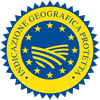Description
The Presunto de Santana da Serra and Paleta de Santana da Serra PGI are hams made from the Alentejana breed of pig. The Presunto is the leg and the Paleta is the shoulder and the pode (the trotter) and rind are kept.
Production Area
Presunto de Santana da Serra and Paleta de Santana da Serra PGI is made in the freguesias (hamlets) of Santana da Serra, Garvão, Ourique, Panóias, Santa Luzia and Conceição, in the municipal area of Ourique, in the Beja district.
Production Method
The pigs are raised in the open air and have a varied diet of grass, cereals, natural vegetation, eggs, small mammals and worms etc. After a fattening period of between 60 and 90 days and at an age of between 12 and 24 months and a weight of at least 90 kg, the pigs are butchered. The leg (with the trotter) and shoulder must respectively weigh at least 7.5 kg and 5 kg. The ham is processed in the local traditional way which is divided into a number of phases: cutting, salting for one to one and a half days per kg at a temperature of between 0°C and 5°C; washing and hanging for between one and three days; drying, for 30 to 60 days at a temperature of between 3°C and 5°C; the minimum maturing period is between four and five months for Presunto and two to three months for Paleta; lastly the hams are cured for a minimum of six months for the Presunto and three months for the Paleta. Both the maturing and curing take place in the natural climatic conditions.
Appearance and Flavour
Presunto de Santana da Serra and Paleta de Santana da Serra PGI is round shaped and oval respectively. Both the rind and the pode (trotter) are kept. The ham weighs over 5 kg and the shoulder at least 3.5 kg. The meat is red in colour, marbled with strips of visible fat. It has an oily surface and a soft consistency. It has quite a strong and very pleasant aroma and a persistent, lightly salty and spicy taste.
History
The origins of Presunto de Santana da Serra and Paleta de Santana da Serra PGI are linked to written testimonials dating back to the 14th century which make references to the king's concern in conserving the oak woods of Ourique. Another reference, made in 1699, is a law establishing the use of the oak woods and the taxes to be paid to the king based on the number of pigs reared. At the beginning of the 20th century guards were employed to protect the woods from acorn thieves. Records still exist today from the 1950s which record the taxes paid by the local sausage makers in the Ourique municipal area.
Gastronomy
Presunto de Santana da Serra and Paleta de Santana da Serra PGI must be stored in a cool dry place and, once sliced must be kept in the fridge; in fact the fat in this ham, which gives it its colour, flavour and aroma, deteriorates very quickly if exposed to the air or to high temperatures. It is normally eaten raw, in very thin slices, cut by hand and served as a starter. It is excellent with a glass of the local wine. In the past it was kept for important occasions or given as a prestigious gift. The superior flavour of this ham is wasted by cooking. In fact in the local cuisine there is not one single dish that includes it as an ingredient.
Marketing
This ham is only sold as Presunto de Santana da Serra and Paleta de Santana da Serra PGI. It is only sold prepacked at source, whole, on or off the bone, in pieces or sliced.
Distinctive Features
The area where this ham is produced has plains to the north and dense oak and cork oak woods. The climate is hot and dry in the summer and cold and dry in the winter. The type of breed and feed given to the pigs gives their meat and fat its particular characteristics. The climate is ideal for curing the hams naturally without having to resort to smoking or other types of preservation except for the addition of salt. An emblem of the Order of Santiago is branded onto the rind of Presunto de Santana da Serra and Paleta de Santana da Serra PGI hams, an ancient symbol of these freguesias which is where these hams are produced today.






